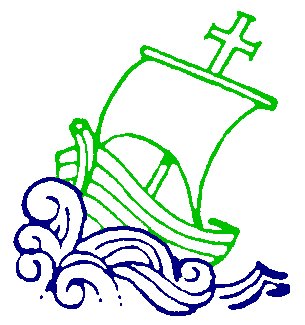
First Arrivals
Some of the first Christians coming to Ireland would in all probability have arrived by the sea-routes from Gaul and settled in the South. But there was another route through Wales. In specifically ecclesiastical matters however, Ireland, like Britain and in common with all the West, looked to Rome, where St Peter and St Paul had been martyred, as the source of authority. In this sense it was always a ‘Roman’ church within the sphere of the chief bishop of the West – who at this time still maintained his proper collegiate relationship with his fellow chief bishops in the East.
The written language of the Irish church was always Latin. The training of Irish monks in Wales must have been significant in this respect. Important early Irish words reveal Latin origins: words for church are ‘kill’ or ‘cell’ from Latin cella, ‘teampall’ from templum, ‘diseart’ for hermitage from deserta.
If the monasteries in Britain and Ireland owed their origins to Gaul, in turn they owed everything to Egypt, and perhaps a little to Syria. The first monks and hermits may conceivably have set up in Britain even as early as the fourth century; but they certainly did so in the 5th and 6th centuries in Wales, southern Scotland and Cornwall. This may have been triggered by refugees, pilgrims, travellers, or, given that many were given to being itinerant, something of all of these.
We are on solid ground however when St Palladius was made bishop and sent by the Pope Celestine to Ireland possibly in 431. A British or Irish monk called Pelagius Brito (430) had appeared in Rome teaching about asceticism. The purpose of Palladius’ visit would have been to see that all things were in order. Clearly by this time there were Christians already there. It is likely that he would also have ordained (more?) bishops.
St Sechnal, St Auxilius and St Iserninus (possibly a Briton) may have been bishops who accompanied Palladius; or they may have belonged to the generation after Palladius’ visit, whether contemporary or not with Patrick. Churches in Dunshaughlin (Co Meath), KiIlashee (Co Kildare) and Aghade (Co Carlow) and Kilcullen (Co Kildare) are said to have been founded by them. The thrust would have been from the south going north. But there is a noticeable intent in the sources to make out that these and other early Christian leaders were connected to or even subordinate to Patrick when it is unlikely that this was the case.
Other early communities of Christians were in South-East Ireland, mostly in Counties Wexford and Waterford. It is said that St Declan was a monk-evangelist in the south in the early 5C. He had blood ties with Wales and probably learnt about the monastic life in South Wales or Gaul. He lived as a hermit at Ardmore in Co Waterford on what was probably then an island. St Ailbe was a friend of Declan, and also a monk evangelist in the south in the early 5C. He founded the monastery at Emly Co Waterford. St Ibar founded the monastery on Begerin Island Co Wexford in the early 5C. The word ’beg erin’ means ‘little Ireland’. It was a tidal island in Wexford Harbour. This area was named by the Greek geographer about AD 150 BC ‘Menapia’. St Ibar and St Abban may have founded a monastery on Lady’s Island Co Wexford. Abban was Ibar’s nephew. The lake is tidal, and had an ancient port. Ardmore, Begerin, Lady’s Island all afforded excellent sea connections with Wales and Gaul. This pattern of using islands should be noted; for many of these places, due to silting, are now joined to the mainland.
St Dubhan (5C), according to tradition, came from Wales and founded a monastery on the Hook peninsula Co Wexford. There was another monastery on Great Island on the Barrow River in Waterford harbour. There was another early St Abban who founded a monastery at Adamstown (= Abbanstown) in Co Wexford. He too is said to have founded monasteries all over the south. St Ciaran (458?) did the same. He was born on Clear Island, Co Cork, and became a hermit. He too went abroad for training and was probably earlier than St Patrick.